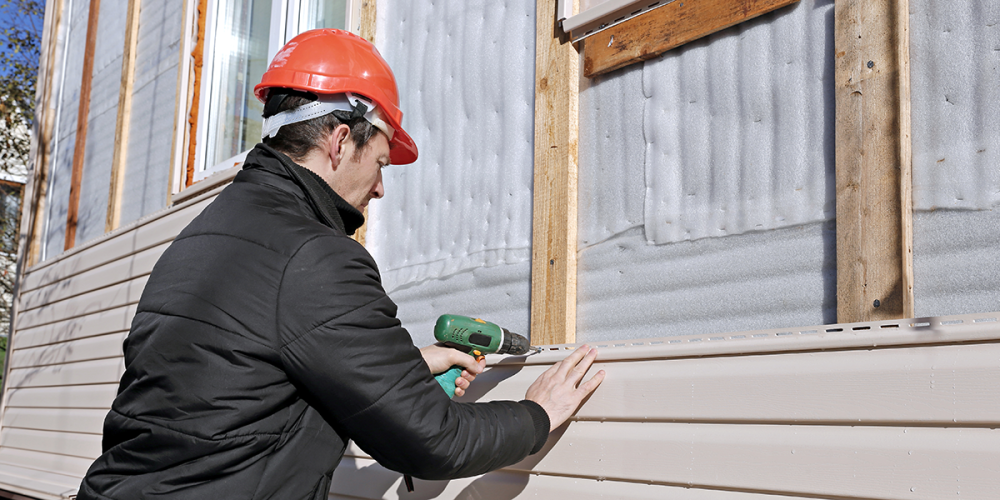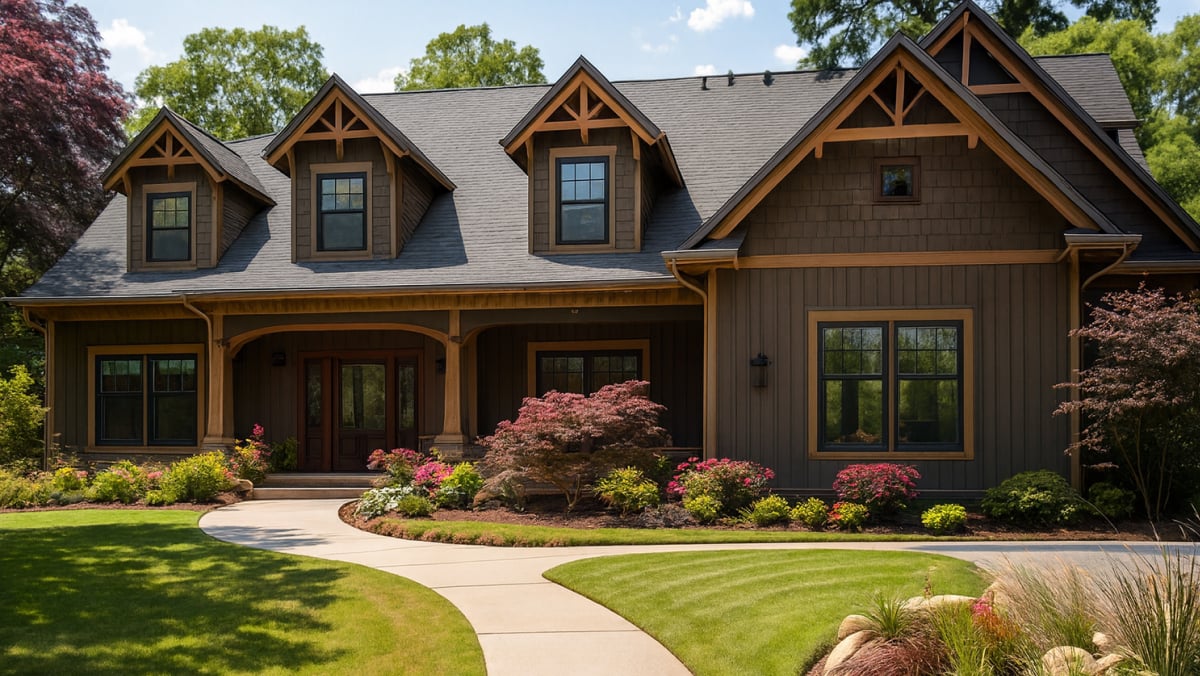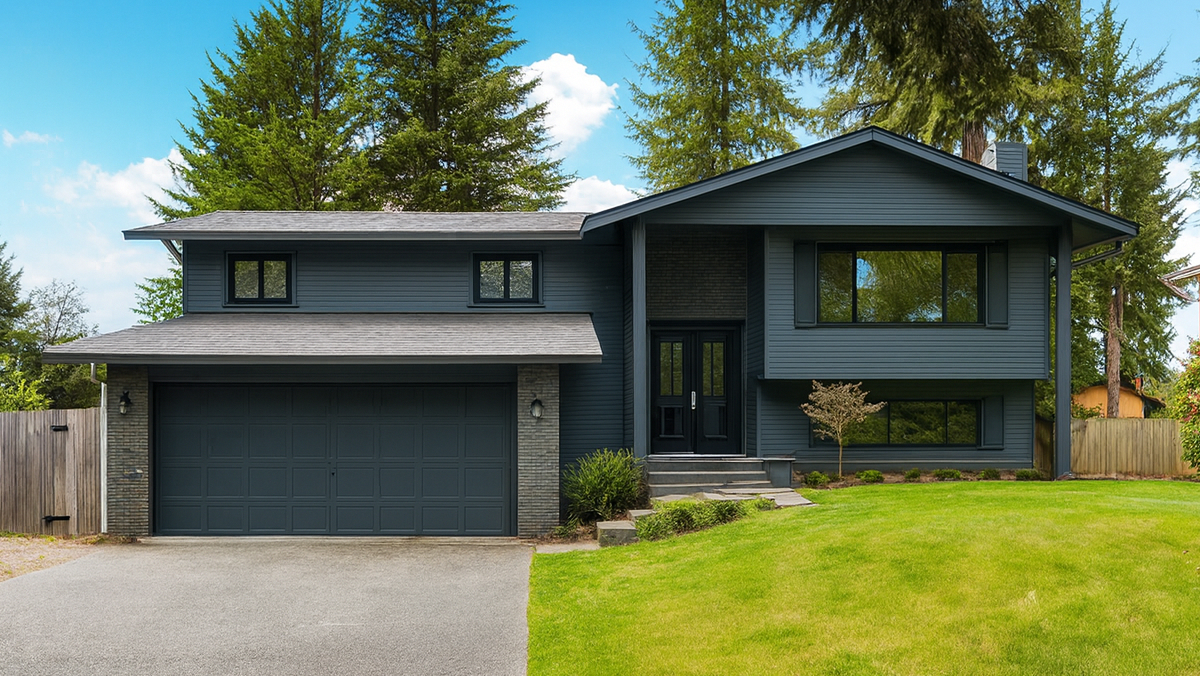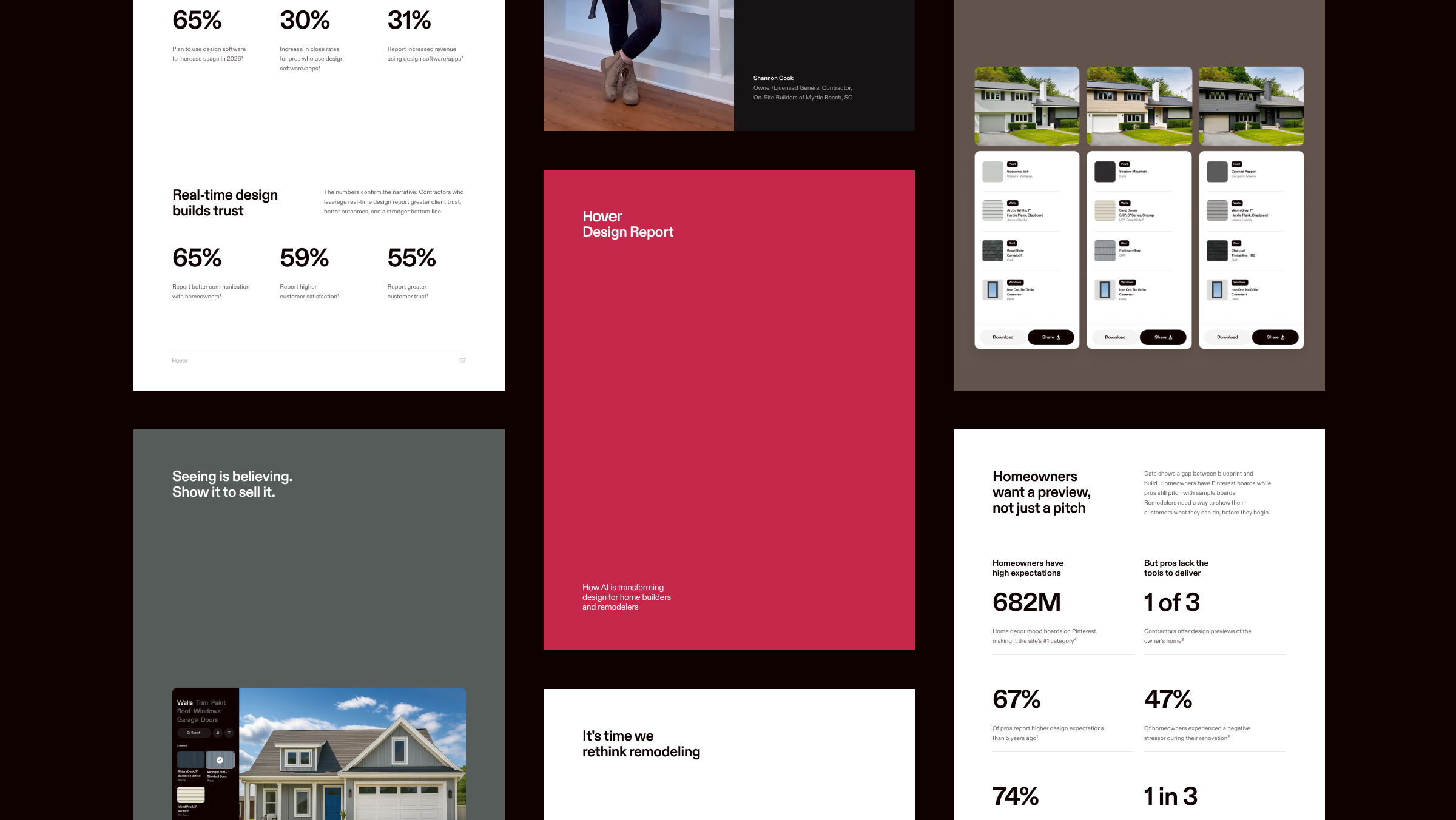Redoing your home’s siding is no small task, and total cost can play a major role in determining when and how it happens. In this article, we’ll break down the different factors that affect the cost of siding and how vinyl compares to other siding options, as well as vinyl's pros and cons.
Factors That Affect Vinyl’s Cost
On average, a homeowner can expect to spend $11,000 on vinyl siding. However, the price can range from $6,000 to $16,400. What causes that $10,000 difference? Quality, location, style, your home’s size, and the labor involved.
Quality
The quality and craftsmanship of vinyl siding play an important role in its price because not all vinyl is the same. Thickness and the length of the siding are key in determining quality. Let’s first look at the different siding grades:
- Builder’s grade: If you’re renovating with a tight budget, this one's for you. Measuring .40mm, it’s the thinnest and cheapest siding option. This grade is used in the majority of residential homes, but it doesn’t provide much insulation and can crack easily.
- Thin residential grade: With a thickness of .42mm, it is still one of the more inexpensive options while providing decent insulation. Although it doesn’t protect against hot, penetrative heat, as well as thicker grades.
- Standard residential grade: At .44mm in thickness, this grade is one of the more common choices. It provides adequate insulation and sturdiness while remaining cost-effective.
- Thick residential grade: Similar to the standard grade, this grade provides decent insulation with a .46mm thickness and can still be cost-effective.
- Super thick grade: Being .50mm thick, this can become a bit pricey. However, these sidings provide good protection against rain and wind and offer lots of insulation.
- Premium grade: This is the most expensive grade on the market measuring .52mm to .55mm thick. It does provide decent protection and insulation from penetrative heat and low temperatures.
As mentioned above, length is the second indicator of vinyl siding quality. Standard siding panels come in 12.5-foot lengths, which can lead to more seams around the outside of the home, reducing its curb appeal. Quality siding comes in longer, 16.7- or 25-foot lengths, which minimize the risk of seams. But it can require greater installation time to ensure the siding is straight and properly installed.
Location
Depending on where you live can be a major factor in your project’s final price. Local labor costs and shipping costs to get the materials to your area are two of the main variables that affect the price.
For example, vinyl holds up remarkably well to the heat and freeze cycles found in the Northeast and Midwest. So it’s much easier to find in those regions, making it less expensive. However, vinyl is prone to warping and cracking in the extremely high temperatures of the Southern states. Since it isn’t used as frequently down there, it will be more expensive to ship vinyl in and install.
Here’s how regional factors influence pricing:
- Northeast and Midwest: More affordable due to the popularity and availability of vinyl siding, which performs well in freeze-thaw cycles.
- Southern States: Higher costs due to the material’s tendency to warp in extreme heat, making it less commonly used and more expensive to source.
- Coastal Areas: Vinyl siding costs may increase due to the need for specialized materials that withstand salt and moisture.
Style
One reason why vinyl siding has become so popular is because of its multiple color and style options. It’s formed in molds, so it can mimic the look of wood lap, brick, and stone siding, as well as shingles, shakes, and even log-look.
Vinyl siding style is arguably one of the biggest contributors to price. Here’s a high-level breakdown of the different styles and their material costs per square foot (not installed):
Traditional lap: $2–$6
- Features overlapping horizontal boards with a clean and classic appearance.
- Ideal for homeowners seeking a timeless, traditional look.
- Estimated cost for a 2,500 sq. ft. home: $5,000 to $15,000.
Smooth: $2–$6
- Provides a sleek and modern surface without wood grain or texture.
- Best for contemporary home designs aiming for minimalism.
- Estimated cost for a 2,500 sq. ft. home: $5,000 to $15,000.
Beaded: $2–$6
- Includes a decorative bead along the bottom edge of each board.
- Adds an elegant, polished appearance, perfect for colonial-style homes.
- Estimated cost for a 2,500 sq. ft. home: $5,000 to $15,000.
Dutch lap: $2–$6
- Features a decorative groove along the top of each board for depth and shadow.
- Popular for adding texture and dimension to a home’s exterior.
- Estimated cost for a 2,500 sq. ft. home: $5,000 to $15,000.
Clapboard: $2–$6
- Mimics the look of traditional wood planks with a straight, horizontal design.
- Offers a versatile aesthetic for both modern and traditional homes.
- Estimated cost for a 2,500 sq. ft. home: $5,000 to $15,000.
Board and batten: $3.50–$9
- Vertical panels with narrow strips (battens) covering the seams.
- Often chosen for its farmhouse or rustic appeal.
- Estimated cost for a 2,500 sq. ft. home: $8,750 to $22,500.
Vinyl shake: $3.50–$9
- Mimics the look of cedar shakes with textured, overlapping pieces.
- Works well for cottages and coastal-style homes.
- Estimated cost for a 2,500 sq. ft. home: $8,750 to $22,500.
Scalloped: $4–$9
- Features rounded edges that resemble fish scales or half circles.
- Often used to add decorative charm to gables or accent areas.
- Estimated cost for a 2,500 sq. ft. home: $10,000 to $22,500.
Log-look: $5–$10
- Simulates the appearance of natural log siding for a rustic, cabin-like feel.
- Ideal for homes in rural or wooded areas seeking a natural aesthetic.
- Estimated cost for a 2,500 sq. ft. home: $12,500 to $25,000.
Brick-look: $5–$10
- Provides the visual appeal of real brick without the high cost or labor.
- Popular for homes aiming for a classic, stately exterior.
- Estimated cost for a 2,500 sq. ft. home: $12,500 to $25,000.
Stone-look: $5–$10
- Replicates the texture and depth of natural stone siding.
- Adds a luxurious, high-end appearance at a fraction of the cost.
- Estimated cost for a 2,500 sq. ft. home: $12,500 to $25,000.
The most popular vinyl siding is Dutch lap. It has a decorative groove along the top of the board that creates dramatic shadow lines across your home. The groove provides a look of greater depth and dimension while adding some curb appeal.
Home Size
Since siding is priced per square foot, it makes sense that the bigger your home is the more you can expect to pay for siding and labor.
The cost of vinyl siding installation ranges from $2.50 to $10.75 per square foot. Homeowners with a 1,000-square-foot home can expect to pay between $2,500 and $10,750 for vinyl siding while homeowners of a 4,000-square-foot home can expect a bill ranging from $10,000 to $43,000.
Cost Breakdown by Home Size and Design
Per Square Foot Analysis:
Vinyl siding costs vary significantly depending on the size of your home. Here’s an estimated breakdown of installation costs for different home sizes:
- Small homes (1,500 sq ft): $3,750 to $16,125
- Medium homes (2,500 sq ft): $6,250 to $26,875
- Large homes (3,500 sq ft or more): $8,750 to $37,625
These figures include material and labor costs. Larger homes typically require more siding and involve longer labor hours, contributing to the higher cost.
Architectural Complexity:
The architectural design of your home can significantly impact the cost of siding installation. Homes with multiple stories, intricate rooflines, or unique features like eaves and gables require additional labor and precise cutting, which increases the overall cost. Simpler designs, such as ranch-style homes, are more straightforward and less expensive to side.
Labor
Depending on where you live, labor costs could vary, but the average labor cost to install vinyl siding is $3.70 per square foot, with the general range being from $2 to $5 per square foot. So, if your home is 1,000 sq. ft. then you can expect to pay $2,150 or $5,250 in labor costs alone.
If you’re looking to cut costs, have your siding replaced in spring or fall when companies are less busy—summertime is their busiest season, so prices tend to be higher. We also recommend using higher-quality siding or insulated siding because it’s easier to install. The lesser grade vinyl siding is floppy and bendable, and it usually takes two people to install in order to prevent bends and breaks.
Material Quality and Thickness
Vinyl siding’s grade and thickness play a crucial role in durability and cost:
- Builder’s grade (0.40mm): Least expensive but less durable.
- Standard grade (0.44mm): A balance of affordability and sturdiness.
- Premium grade (0.52mm to 0.55mm): More expensive but offers superior durability and insulation.
Additional Cost Factors
Removal of Existing Siding
If your home has existing siding, removal costs can range from $1,000 to $3,000. This includes labor for tearing down old materials and disposal fees. Some contractors may include this in their estimates, while others charge separately.
Repairs Before Installation
Before installing new siding, underlying structural repairs may be necessary. Rotting wood, damaged insulation, or water damage can add $500 to $2,000 or more, depending on the severity.
Insulation Upgrades
Adding insulation during your siding installation can increase upfront costs by $1,000 to $3,000, but it improves energy efficiency and reduces heating and cooling expenses in the long term.
Example Cost Sheet: Vinyl Siding Project for a 2,500-Square-Foot Home
Understanding the potential costs of a vinyl siding project can help homeowners budget effectively and avoid surprises. While each project will have unique requirements depending on the home’s size, location, and style preferences, breaking down individual line items can provide a clearer picture of where the money goes. Below is a detailed example cost sheet for a 2,500-square-foot home, showcasing typical expenses for materials, labor, and additional components necessary for a successful siding installation.
|
Siding Installation Line Item |
Cost |
|
Siding Installation Permit |
$250 |
|
Finishing Strips |
$26.40 (8 strips x $3.30 each) |
|
Starter Strips |
$68.75 (25 strips x $2.75 each) |
|
Corner Trim (Inside & Outside) |
$115.60 (10 pieces x $11.56 each) |
|
J-Channels |
$378.00 (105 pieces x $3.60 each) |
|
Moisture Barrier Wrap |
$500.00 |
|
Soffit Panels |
$425.00 (50 sq. ft. at $8.50 each) |
|
Insulated Backing Boards |
$1,250.00 |
|
Hydrants, Outlets, and Vents (e.g., plug-in outlets, light fixtures, gable vents, hydrant faucets) |
$375.00 |
|
Shutters |
$546.00 (14 pieces x $39.00 each) |
|
Nails and Fasteners |
$75.00 |
|
Additional Costs |
$70.00 delivery charge and $320 garbage rental |
|
Old Siding Removal Cost |
$1,400.00 |
|
Estimated Labor Cost |
$9,250.00 (2,500 sq. ft. x $3.70) |
|
Estimated Siding Material Cost |
$8,750.00 (2,500 sq. ft. x $3.50 for mid-grade vinyl siding) |
Estimated Total Cost for Siding Installation: $23,799.75
Vinyl Costs vs. The Cost of Other Siding Types
As stated, homeowners love vinyl siding because it’s durable, easy to install, and relatively inexpensive compared to other siding options. Let’s look at the other materials’ costs in comparison (all prices are per square foot, installed). Reminder: The average cost of vinyl siding is $2.50 to $10.75 per sq. ft. installed.
Here's an expanded comparison of common siding options, along with additional details to help you make an informed decision.
Wood Siding: $2.25 to $15 per sq. ft. installed
-
Why Choose Wood? Wood offers a timeless, classic look with unparalleled charm. It can be painted or stained to match any aesthetic. Popular types include cedar, redwood, and pine.
-
Considerations: High maintenance is required, including painting or sealing every few years. Wood is susceptible to pests, moisture, and fire, making it less durable in certain climates.
Aluminum Siding: $3.00 to $7.25 per sq. ft. installed
-
Why Choose Aluminum? Lightweight and resistant to rust and insects, aluminum is a practical choice for homes in wetter climates. It’s also recyclable and eco-friendly.
-
Considerations: Aluminum can dent easily and may fade or chalk over time, requiring occasional repainting. It can also make a "pinging" noise during heavy rain or wind.
Engineered Wood: $3.40 to $9.25 per sq. ft. installed
-
Why Choose Engineered Wood? This material combines the aesthetic appeal of natural wood with better resistance to moisture and pests. It's pre-treated for added durability and comes ready to paint.
-
Considerations: Installation must be done carefully to avoid water infiltration, which can cause swelling or warping. Regular maintenance is still required.
Steel Siding: $4.25 to $8.75 per sq. ft. installed
-
Why Choose Steel? Extremely durable and fire-resistant, steel is ideal for areas with extreme weather conditions, such as hail or strong winds. It requires little maintenance.
-
Considerations: Heavy and expensive to install, steel siding can rust over time if not properly coated or maintained. The initial investment is higher than vinyl or aluminum.
Fiber Cement: $4.50 to $11.25 per sq. ft. installed
-
Why Choose Fiber Cement? A versatile option, fiber cement mimics the look of wood, stone, or brick but is far more durable. It’s resistant to pests, rot, and fire, and it performs well in extreme climates.
-
Considerations: Fiber cement is heavy, making installation more labor-intensive and costly. It also requires periodic repainting to maintain its appearance.
Stucco: $5.50 to $7.50 per sq. ft. installed
-
Why Choose Stucco? Stucco provides a textured, durable finish with excellent insulation properties. It’s especially popular in arid regions due to its resistance to heat and dryness.
-
Considerations: Stucco can crack in wet or humid climates, and repairs can be expensive. Skilled installation is required to avoid early failure.
Brick Veneer: $8 to $13 per sq. ft. installed
-
Why Choose Brick Veneer? A cost-effective alternative to solid brick, veneer provides the same classic look with lower material and labor costs. It’s durable and requires minimal maintenance.
-
Considerations: Proper installation is essential to prevent moisture infiltration. Veneer doesn’t offer the same structural benefits as full brick siding.
Brick: $11 to $27 per sq. ft. installed
-
Why Choose Brick? Timeless and incredibly durable, brick siding provides excellent insulation and weather resistance. It’s also fireproof and nearly maintenance-free.
-
Considerations: Brick is heavy and requires skilled installation, which drives up costs. Mortar joints may need occasional repairs over time.
Stone: $21.50 to $38.75 per sq. ft. installed
-
Why Choose Stone? Stone is the pinnacle of luxury and durability. It’s weather-resistant, fireproof, and nearly indestructible, making it ideal for upscale homes.
-
Considerations: Stone is among the most expensive siding materials, both in terms of materials and labor. Its weight requires a strong foundation for installation.
If you love the look of wood, stone, or brick but don’t love the price tag, no worries! Vinyl comes to the rescue once again. You can choose a brick-look, stone-look, or wood-look vinyl siding style to get the look you love at about half the price.
Tips On How to Lower Your Vinyl Siding Cost
Even though vinyl siding is the less expensive option, re-siding your home still isn’t a pleasant cost to bear. But there are ways to minimize the financial burden.
Look for Offseason Discounts
If you can plan ahead for your siding replacement, aim to have it done during the slow season. Early spring and fall are prime times to have your siding replaced because it’s outside the peak season. You should be able to find some decent deals from siding contractors looking for business.
Choose Your Material Wisely
There’s no need to splurge on premium grade siding when standard or thin residential grade will do the trick! And when you are choosing your siding be sure to pay attention to the vinyl’s texture. Flat or lightly textured siding is usually less expensive than deeply textured options.
Shop Around
We recommend getting more than one quote for the job. While you’re shopping around, be sure to ask about the different brands of siding and their costs. Some contractors work exclusively with one brand, so you might find a better deal with a different contractor who works with multiple or cheaper manufacturers.
Climate Impact on Material Performance
Certain climates demand siding with specific characteristics. For instance:
-
Humid climates: Vinyl siding can resist moisture but may require mildew-resistant finishes.
-
Cold climates: Thicker vinyl siding grades perform better against cracking during freeze-thaw cycles.
-
Hot climates: Insulated vinyl siding is a better choice to minimize warping in high temperatures.
Tax Breaks
Insulated siding or rigid board insulation under your siding helps to keep the home’s temperature stable. A better insulated home means a more energy-efficient home. Check with your state and local government about tax breaks related to increasing energy efficiency.
Vinyl Siding Pros and Cons
Durable, inexpensive, and easy to install; you may not think there are many disadvantages to installing vinyl siding to your home. However, before you make your final decision about how to side your home, here are some pros and cons:
Pros
Vinyl siding is extremely durable—insects won’t infest vinyl siding, a hailstorm can’t dent it, and the sun won’t fade it. Unlike other types of siding, there’s no need to worry about it crumbling and showing its age. It can last for decades, depending on climate, quality, and maintenance.
It’s a lower-cost option than other siding choices. Aluminum siding is the only other type that is cheaper than vinyl. And while it does have its own advantages, aluminum siding is prone to denting and warping, whereas vinyl is not. Plus, vinyl has cheaper maintenance costs, making it less money in the long run.
And when we say vinyl siding is low maintenance, we mean it. A hose and some soapy water and, after a particularly wet season, perhaps a power washer—that’s it. In extreme cases, after an intense storm, your vinyl siding might need resetting. But there’s no need for regular scraping and painting, repainting, recoating, or insect treatment with vinyl.
The color of vinyl siding is inherent to the material. This means that the color was present in the material before it was ever formed into the panel, not applied afterward. So the color won’t chip off or fade and you won’t have to repaint your home.
Cons
Installation is easy but not foolproof. And if done incorrectly, it could lead to a lot of issues down the road. Even though it adds an additional cost element, we’d recommend using a contractor to ensure correct installation.
Vinyl siding might be cheaper in the immediate future, but it could decrease the value of your home in the long term. If your home is historically significant, vinyl siding can devastate your home's worth. And, unfortunately, some home buyers regard vinyl as inferior which could decrease your home’s offers when it comes time to sell.
Finally, if a panel of your vinyl siding is damaged by extreme weather, then the whole panel will have to be replaced. Unfortunately, there is no such thing as patchwork when it comes to vinyl siding.
Visualize Your Vinyl Siding Options
Homeowners can use Hover to visualize what your home could look like with vinyl siding! Hover’s application allows you to see what different types of vinyl siding will look like on a 3D model of your existing home. Hover lets you experiment with different colors and styles, so you can show your contractor exactly what you want.
Contractors can also provide you with an accurate estimate based on Hover’s measurements, so you can make your home improvement dreams become a reality.
Click here to learn more and see how it works!



